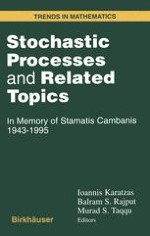In the last twenty years extensive research has been devoted to a better understanding of the stable and other closely related infinitely divisible mod els. Stamatis Cambanis, a distinguished educator and researcher, played a special leadership role in the development of these research efforts, particu larly related to stable processes from the early seventies until his untimely death in April '95. This commemorative volume consists of a collection of research articles devoted to reviewing the state of the art of this and other rapidly developing research and to explore new directions of research in these fields. The volume is a tribute to the Life and Work of Stamatis by his students, friends, and colleagues whose personal and professional lives he has deeply touched through his generous insights and dedication to his profession. Before the idea of this volume was conceived, two conferences were held in the memory of Stamatis. The first was organized by the University of Athens and the Athens University of Economics and was held in Athens during December 18-19, 1995. The second was a significant part of a Spe cial IMS meeting held at the campus of the University of North Carolina at Chapel Hill during October 17-19, 1996. It is the selfless effort of sev eral people that brought about these conferences. We believe that this is an appropriate place to acknowledge their effort; and on behalf of all the participants, we extend sincere thanks to all these persons.
